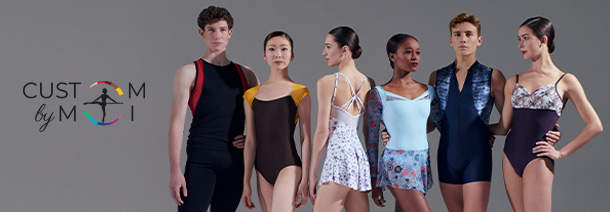OUTLET Up to 40% off - Free delivery from $75 * -
View Details- Menu
- Women
- Men/Boys
-
Girls DancewearLeotardsDressesSkirtsTightsTops & ShortsUndergamentsWarm UpActivewearBallet shoesPointe ShoesSoft ShoesShoe AccessoriesBags & AccessoriesBagsMasksAccessoriesFeaturedCollection PremièreCollection ClassiqueCollection Éclat de FleursCollection MademoiselleBestsellersGift Card
- Custom By Moi
- World of Wear Moi
- Shop social
- Outlet
- Stores
-
Women
 Dancewear
LeotardsDressesSkirtsTightsTops & ShortsUndergarmentsActivewearWarm Up
Dancewear
LeotardsDressesSkirtsTightsTops & ShortsUndergarmentsActivewearWarm Up Ballet shoes
Pointe ShoesSoft ShoesShoe Accessories
Ballet shoes
Pointe ShoesSoft ShoesShoe Accessories Bags & Accessories
BagsMasksAccessories
Bags & Accessories
BagsMasksAccessories Featured
Collection Damasco - NEWCollection PremièreCollection CoutureCustom by MoiBestsellersGift Card
Featured
Collection Damasco - NEWCollection PremièreCollection CoutureCustom by MoiBestsellersGift Card Bestsellers
Bestsellers
 Custom By Moi
LeotardsDressesSkirtsTopsBottomsUnitardsFabric sample card
Custom By Moi
LeotardsDressesSkirtsTopsBottomsUnitardsFabric sample card -
Men/Boys
 Dancewear
TopsLeotardsTightsUnitards & BiketardsShortsDance BeltsWarm Up
Dancewear
TopsLeotardsTightsUnitards & BiketardsShortsDance BeltsWarm Up Soft Shoes
StretchNon-Stretch
Soft Shoes
StretchNon-Stretch Masks
Masks
 Featured
Custom by MoiGift CardBestsellers
Featured
Custom by MoiGift CardBestsellers Custom By Moi
LeotardsUnitardsTopsBiketardsShortsTightsFabric sample card
Custom By Moi
LeotardsUnitardsTopsBiketardsShortsTightsFabric sample card -
Girls
 Dancewear
LeotardsDressesSkirtsTightsTops & ShortsUndergamentsActivewearWarm Up
Dancewear
LeotardsDressesSkirtsTightsTops & ShortsUndergamentsActivewearWarm Up Ballet shoes
Pointe ShoesSoft ShoesShoe Accessories
Ballet shoes
Pointe ShoesSoft ShoesShoe Accessories Bags & Accessories
BagsMasksAccessories
Bags & Accessories
BagsMasksAccessories Featured
Collection PremièreBestsellersCollection ClassiqueCollection Éclat de FleursCollection MademoiselleGift Card
Featured
Collection PremièreBestsellersCollection ClassiqueCollection Éclat de FleursCollection MademoiselleGift Card Bestsellers
Bestsellers
-
Outlet WomenMenGirls
-
Stores Boutique Toulon (France)Chicago Store (IL, USA)
-
Information Contact UsFAQSize chartsResellers access
- Custom by Moi
- Gift card
- Newsletter
-
World of Wear Moi HistoryLookbookInside Wear MoiBlogCatalogShop social















.jpg)